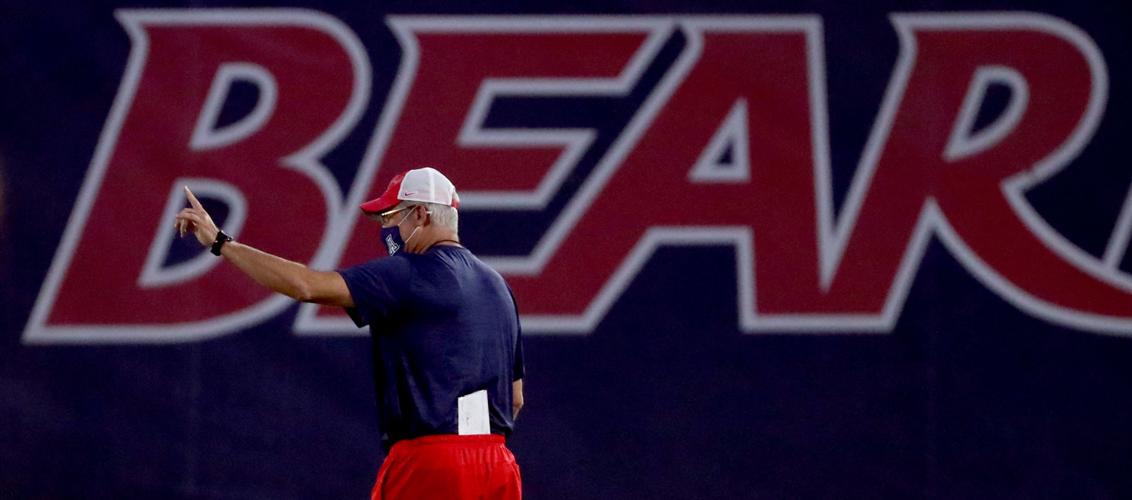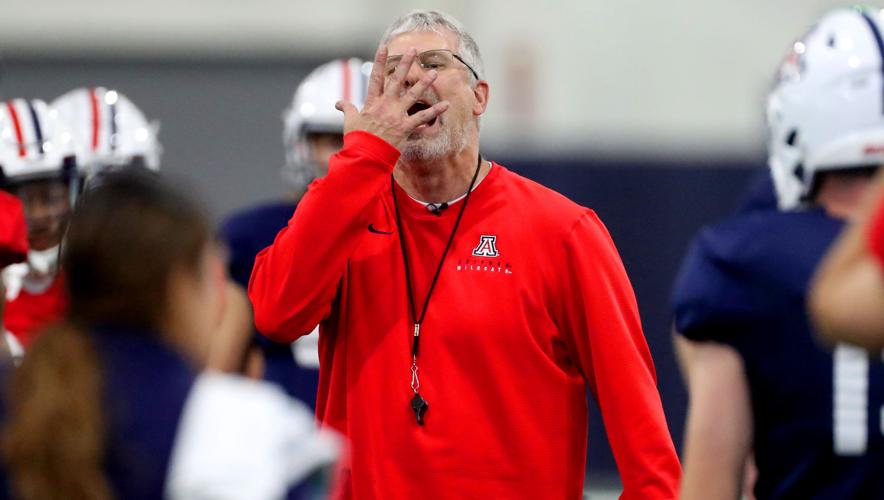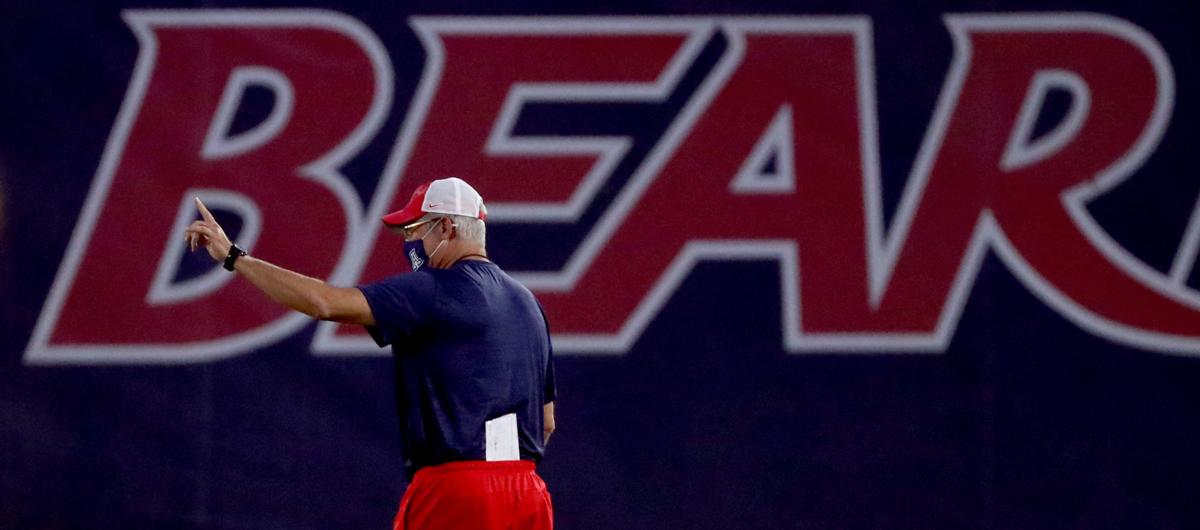March 5 feels like a lifetime ago. But some things stick with you. For instance: New Arizona defensive coordinator Paul Rhoads’ response to a question that day about the Wildcats’ defensive depth.
“What depth?” Rhoads quipped.
Back then, Rhoads thought he would have four experienced seniors around whom he could rebuild a UA defense that has struggled for years. Since then, those four players — linebackers Tony Fields II, Colin Schooler and Kylan Wilborn, and safety Scottie Young Jr. — have transferred or entered the portal. A fifth, defensive end JB Brown, opted out of the 2020 season.
So if Rhoads was implying in March that the Wildcats had no defensive depth, what do they have now?
“We’re gonna field a team,” Rhoads said Monday night after Arizona’s third practice of fall camp. “And we’re going to go out there and play our tails off and be where we’re supposed to be … hustle, play extremely hard. And we’re going to strive and work to be one of the finest tackling football teams in America. How we patch that (together) remains to be seen.”
In other words: Your plans and personnel might change, but you can’t let that affect your principles.
Although the Wildcats’ personnel has changed, and depth at certain spots is a bigger concern than ever, Rhoads won’t waver from the tenets he presented at his introductory news conference last December.
“We certainly came here to run a scheme,” Rhoads said. “You don’t scrap the scheme and shift and decide to do something else. However, you begin to figure out what it is you can do with the personnel that’s available to you. That’s what we’re in the process of doing right now.”
Rhoads and the defensive staff already have moved some pieces around. Senior Anthony Pandy, who was supposed to play outside linebacker, is now playing inside. Freshman Derick Mourning, who played on the outside in high school, also has joined the inside-linebacker group, which Rhoads coaches. Redshirt sophomore Issaiah Johnson has shifted from defensive end to outside ’backer.
Even with those moves, the Wildcats have only six healthy scholarship linebackers. Ideally, they’d have twice that many to run a 3-4 system.
“Everybody’s operating like everybody that’s eligible could be on the field Nov. 7,” Rhoads said.
Arizona opens the shortened 2020 season that day at Utah. It’s 3½ weeks away.
Pandy’s the one
In the original plan, Pandy was supposed to be one of the Three Amigos. He was supposed to play alongside classmates Fields and Schooler, as often was the case last season.
Now Pandy is the Lone Ranger.
Among the inside linebackers, he’s the only one with any substantial experience. Pandy has appeared in 34 games, including eight starts.
“I’m calling the shots on defense,” said Pandy, who has taken over the “Mike” linebacker spot. “Since they left, I realized that I have to step up a lot, mature more, set the example and just try to teach the freshmen what Colin and Tony taught me. … They helped me out, so I’m gonna do what I can to help out these freshmen.”
Although he was part of the same 2017 recruiting class as Fields and Schooler, it took a while for Pandy to become a significant contributor. Fields started from Day 1; Schooler joined him in the lineup about a month into the ’17 season.
The inside-linebacker room features a pair of scholarship freshmen: Mourning and Jabar Triplett. Triplett surely would have played this season had he not suffered a torn Achilles tendon in April.
Among the six scholarship linebackers, only Pandy and redshirt junior Jalen Harris have started a college game. Some combination of Mourning, Johnson and second-year players Derrion Clark and Kwabena Watson will fill out the starting foursome, assuming Rhoads sticks with that alignment.
Regardless, Pandy will play a pivotal role. Barring injury or exhaustion, it’s hard to imagine any circumstance where he’d come off the field.
Pandy spent the offseason preparing for just such a scenario. He changed his eating habits and worked on his lower-body explosiveness.

Paul Rhoads joked about his team’s lack of depth in March, before the roster was decimated even more by departures.
“Physically, I feel like I might be in the best shape of my life right now,” Pandy said, adding that he’s “just trying to take care of my body because I know I’m going to be on the field a lot.”
With the team back together after a fractured summer, Pandy is getting a chance to lead his unit. His efforts haven’t gone unnoticed.
“Pandy’s at the front of the drills,” UA coach Kevin Sumlin said. “You see him communicating with these younger guys.”
Keeping it simple
Assuming Pandy stays healthy and can build off his promising 2019 campaign — he finished with 66 tackles, five stops for losses, one forced fumble and one interception — Arizona will have a reliable veteran to run the show. But don’t expect to see any overly complicated game plans.
“I don’t think we can be as creative,” Rhoads said. “I talked to a coaching colleague this past week who is much further along than us, and they’re playing basically about three calls, because they thought that’s all they could really get taught and go out there and execute.
“We’re trying to give our kids exposure to more than that. But the closer we get to Game 1, we’ll decide what it is we need and what it is we can really play. The creative piece might come in the form of some disguise and movement and things like that, but it won’t be in the fashion of multiple calls and defenses.”
Rhoads sympathizes with his fellow defensive coordinators, who have struggled to get stops during the early portion of the season. Division I FBS teams are averaging 30.4 points per game. The Alabama-Ole Miss final — 63-48, in — looked more like a basketball score.
Rhoads said he has viewed those games and box scores “with great concern” — especially considering that most of the teams that already have played had traditional training camps, or something close to it.
“It’s a tremendous challenge for us to get this football team … ready to play sound football,” Rhoads said. “The positive is, everybody else in our league is doing the same thing.”
It isn’t the only positive. Arizona does have better defensive depth somewhere. Since spring, the Wildcats have added five scholarship defensive linemen. Additionally, graduate transfer Aaron Blackwell is healthier after being limited in spring workouts.
“Those are six good-looking defensive linemen that we didn’t have on the field in March,” Rhoads said. “Things are always built from the front to the back.”
Preferably without holes in between. But there’s nothing Arizona can do about that now. The Wildcats have what they have. Fields and Schooler aren’t coming back.
“They did what’s best for them,” Pandy said. “With or without them, we’re gonna play to win. We’re gonna play hard. There’s not much else to say about that.”
Extra points
- Center Josh McCauley, who reported a knee injury last week, did not participate in Tuesday's practice.
- Sumlin spent time coaching up the punt returners. The group consisted of Jamarye Joiner, Brian Casteel, Michael Wiley, Jaden Mitchell, Christian Roland-Wallace, Bobby Wolfe and Lorenzo Burns.
- The returners fielded balls from punters Kyle Ostendorp and Jacob Meeker-Hackett. Both struck the ball well, with good hang time and placement.
- Freshman running backs Frank Brown Jr. and Jalen John got looks at gunner on the punt-coverage team.






